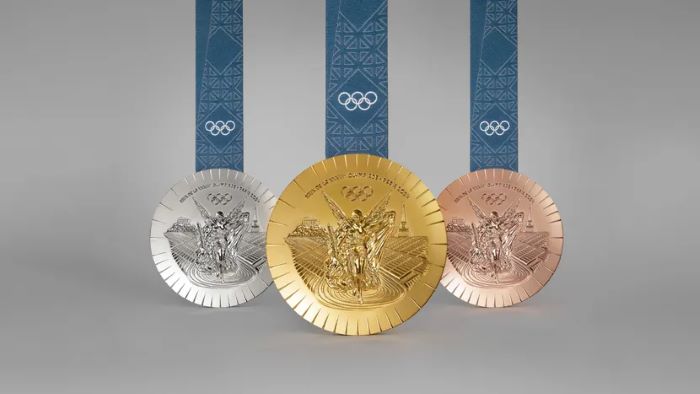Sports
Unveiling the Value and Symbolism of the Paris 2024 Olympic Medals

- The 2024 Paris Olympic medals are notably valuable, with the gold medal costing approximately $950 due to high gold prices and unique materials, including iron from the Eiffel Tower.
- Designed by Chaumet, the medals feature intricate symbolism, including the Eiffel Tower’s lattice work and Parisian elements, reflecting both historical and modern significance.
- The medals’ ribbons are adorned with Eiffel Tower motifs, with Olympic ribbons in dark blue and Paralympic ribbons in deep red, echoing the colors of the tower’s original paint.
The ceremony that opened the 2024 Paris Summer Olympics, officially called The Games of the XXXIII Olympiad Paris, has attracted worldwide attention since its opening on July 26. The Games will feature around 10,500 athletes in 32 different sports and 329 events for medals. The Olympics are not just an athletic spectacle but also a celebration of the past and craft, particularly in the case of awards given to the athletes.
The Intrinsic Value of Olympic Medals
The 2024 Olympic medals are notable not just because of their symbolism but in their actual worth. The price of the podium for a gold medal amounts to about $950. The price of gold, silver and iron influences this. It is one of the most expensive gold medals in Olympic history. It is more valuable than the $708 Olympic gold medals of the 2012 London Olympics awards.
Although it is a high-value item, it isn’t entirely made of gold. It weighs 529 grams. The medal has fifty-five grams of silver, 6 grams of gold plating, and an iron weight of around 18 grams. If the medal were entirely made out of gold, it’s worth would range from $41,161.50. The silver-coloured medal, made up of 507 grams of silver and 18 grams of iron, has a value of around $486. The bronze medal, constructed out of 415.15 kilograms of copper, 21.85 grams of zinc, and the equivalent of 18 grams of iron, comes with approximately $13.
A Touch of Parisian History
What makes the 2024 medals extra distinctive is their link to the Parisian past. The iron used in these medals originates from the Eiffel Tower, an emblem of Paris and France. It was made from the removed sections as the tower was modernized at the turn of the century. It was then improved through Pompey, France. This famous material provides historical significance to the awards.
Chaumet’s Artistic Touch
The designs were created by the famous French jeweler Chaumet. The renowned French jeweler Chaumet designed the medals with elaborate symbolism and exquisite craftsmanship. The central hexagonal shape, which depicts France’s geographical shape, is decorated with the logo that will be used for the Paris 2024 Olympic Games. The emblem blends the Olympic flame and Marianne’s image, symbolizing The French Revolution and national identity. Metal rays reflect”the “City of Light,” making the medals more radiant and expressing the spirit of the Games.
Chaumet’s designs also feature his “griffe setting” technique, inspired by the rivets of the Eiffel Tower. This adds the look of Parisian style to every medal. On the medals’ reverse is adorned with Goddess Athena Nike, symbolizing the renewal of the ancient Games, the Acropolis, and the Eiffel Tower. This ties the old Greek history of the Olympics alongside the current Parisian background.
To award Paralympic medals, Chaumet designed an original design with an up-facing Eiffel Tower view. The design incorporates the phrases “Paris” and “2024” in Braille in honor of the inventor Louis Braille and ensures accessibility to athletes who have visual impairments. These medals stand out with lines of engraving on the edges that indicate either silver or gold bronze.
Ribbons That Tell a Story
The Medals ribbons are similarly symbolic. The latticework of the Eiffel Tower and the Olympic ribbons are deep blue. Likewise, they are the Paralympics. The ribbons are red, resembling the colors of the original Eiffel Tower paint.
The 2024 Paris Olympics medals are not simply awards but objects of history and art. From their precious materials and historical connections to elaborate designs by Chaumet, the medals blend athletic excellence and cultural significance, making the medals a beloved image of the Game’s heritage.


















































